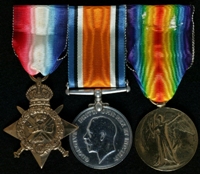

(L to R) 1914 Star; British War Medal; Allied Victory Medal
Thomas was born between October and December 1889 in Holborn, London. His father was called William and his mother was Sarah. He had 8 older siblings; William, Edward, Ellen, Henry, Timothy, Alfred, Eliza Ann and Sarah, and a younger brother called Charles.
In 1891 the family lived at 11 Clarence Place in Finsbury, London. William worked as a French polisher. William and Edward had followed in their father's footsteps and become French polishers. Several of Thomas' other siblings also had jobs.
Thomas' mother died between April and June 1894, aged 45. William married again between October and December 1897 to Louisa Florence Goodwin. She already had a son called Frederick Allen, and they would have a daughter named Ada.
In 1901 Thomas, Sarah and Charles lived at 22 Union Road in Edmonton in East London. They lived with Edward and his family of a wife, 3 daughters and a son. Edward supported them all with his work as a French polisher.
We don't know what Thomas did once he was old enough to work, but it must not have appealed to him very much, because on the 24th November 1908 he joined the Army.
Thomas enlisted in the Manchester Regiment and was given the service number 1414. We don't know anything about the first 3 years of his Army career.
By mid 1911 Thomas was serving with the 2nd Battalion of the Manchester Regiment at Mullingar in County Westmeath, Ireland. On the 7th July the battalion moved to Phoenix Park in Dublin, to join 4 other battalions. They were there to receive new colours from King George V.
Colours are large flags that are unique to each Regiment. They have the unit's battle honours and other distinctive emblems displayed on them, and they represent the history and achievements of the regiment. By 1911 they were no longer carried into battle for troops to rally around, but they took pride of place on parade. The 2nd Battalion's new colours replaced ones that had been awarded in 1886.
Over 40 years later Thomas remembered an incident that took place during this parade. 'During the gallop past a trooper fell from his horse. General [Edward] Fanshawe, seeing what had happened, immediately galloped and stood with his horse astride the prostrate soldier thus protecting him from being hurt by the next column'. The fallen soldier was an artilleryman, and Edward was praised for saving his life by King George.
The 2nd Battalion stayed in Dublin until August, when they returned to Mullingar. The next month they moved to the Curragh Camp in County Kildare.
Here, in 1913, Thomas was promoted to Lance Corporal. Later that year the battalion was reorganised from 8 Companies into 4. Thomas had been a member of either E or F Company before this; he was now in C Company. This was commanded by Henry Theobald, whose medals are also in the Museum of the Manchester Regiment collection.
The First World War broke out on the 4th August 1914 and the 2nd Battalion was ordered to mobilise and proceed overseas. The battalion arrived in Le Havre, France on the 16th August and disembarked and unloaded their equipment overnight. They were then taken by train to Le Cateau and began marching towards the Mons-Conde Canal at Warmes and the invading German Army.
Thomas first saw action on the 23rd August as the British encountered the Germans and began to fall back. They retreated over the next 3 days until they were back at Le Cateau. The British decided to make a stand here on the 26th.
The Battle of Le Cateau was fought against heavy odds against a much larger German force. The 2nd Battalion was held in reserve at first, but heavy German attacks forced them to support their comrades in the front line. The German attacks continued, and as more and more men were killed and wounded it became clear that the British could not hold on. More German units were beginning to outflank the battalion's position, so it was decided to retreat.
The 2nd Battalion lost around 350 men killed, wounded or missing at Le Cateau, out of a total strength of just over 1000. The battle had slowed the German advance, and bought time for the British and French to regroup and stop the German advance at the Battle of the Marne in early September.
Thomas was taken prisoner at Le Cateau, although he is recorded as being 'interned in Holland' rather than captured by the Germans. The Netherlands was neutral in the First World War. Soldiers from either side who entered the country would not be allowed to leave until the end of the war. Around 1700 British soldiers and sailors were interned in total. We don't know how Thomas reached the Netherlands.
The war ended in November 1918 and Thomas will have been released to return home soon afterwards. On the 4th February 1919 he was discharged from the Army for being 'no longer physically fit for war service'. He was awarded a Silver War Badge, with serial number B128392, to show that his discharge was honourable.
We don't know what Thomas did over the next decade, although we believe he returned to London. By 1928 he had begun to work for the Civil Service, and we believe he joined the Civil Service Commission. This is an independent body that helps to ensure that the Civil Service recruits fairly and remains impartial and objective in its work for the Government.
Between October and December 1930 Thomas married Louisa Sophia Hiscock in Shoreditch in the East End of London. She was 12 years younger than him, and they would have 2 children; Thomas W. G. between April and June 1932, and Marilyn L. between July and September 1942. Marilyn was born in Bournemouth in Sussex.
The Manchester Regiment Old Comrade's Association had a London Branch, and after the Second World War Thomas became involved with them. He joined in mid 1950.
By January 1953 Thomas and Louisa lived at 28 Baron Street in Finsbury. This would be his home for the rest of his life.
A few months before this Thomas had met one of Edward Fanshawe's sons. They had discussed the 1911 parade. He 'was very interested to meet someone who was actually present at the time' and 'later he came specially to our office to leave some newspaper cuttings for me to read and said his father was very pleased to hear about our meeting'.
Thomas described this in a letter to the Manchester Regiment Gazette in January 1953. Edward died in November 1952, aged 95.
On the 6th January 1954 Thomas retired from the Civil Service Commission as a senior messenger. He was presented with the Imperial Service Medal to recognise the 25 years or more he had spent working in the Civil Service.
Thomas died suddenly on the 15th December 1958 'on the way to St Bartholomew's Hospital'. He was 69.
Louisa remarried to William J. Roberts in early 1966. She died in March 1980 in Greenwich, aged 78.
Thomas' medals were donated to the Museum of the Manchester Regiment in June 1959. He was also eligible for the '5th Aug.-22nd Nov. 1914' clasp to his 1914 Star.




